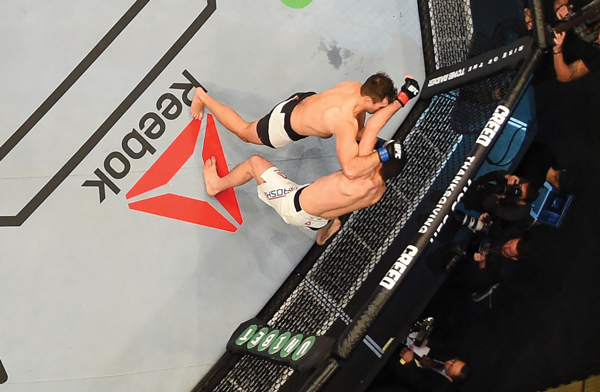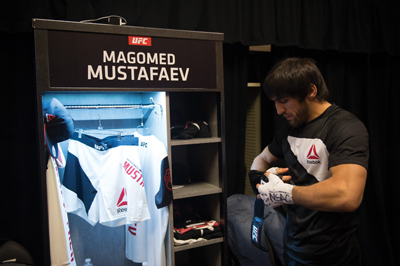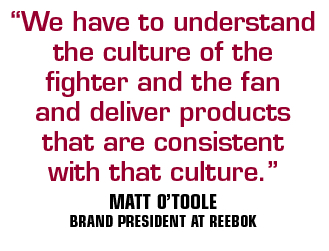The Reebok apparel designer stood in front of a meeting room at a Las Vegas resort earlier this month, delivering a PowerPoint presentation to an audience of 40 UFC fighters from nine countries and four continents, his words translated by interpreters seated in booths at the back of the room.
“We’ve come in very humble,” Marc Leonardo told the group, convened for two days of informational sessions as part of the promotion’s ongoing Fighter Summit series. “We’re here to learn from you. That’s what today is all about. We have some product that we want you to see. We want to get your opinions, good or bad, and apply [them] to be better than ever before.”
To his right hung apparel designed specifically for mixed martial arts athletes; uniform kits for use in the octagon and gear designed for training. In breakout sessions later in the day, many of the fighters would stop by, offering the very feedback that the designers from Reebok’s new combat sports division had requested.
 |
Gian Villante (left) takes on Anthony Perosh during UFC 193 last November.
Photo by: Getty Images |
When the UFC unveiled its first Reebok fight kits during International Fight Week in Las Vegas in July last year, it marked a massive shift for the sport. Gone were the various sponsor patches that had adorned fighters’ shorts, a mish-mash of names and logos known by few outside the hard-core fitness world, a sea change that accomplished what the UFC had intended, taking a sport born on the fringe one step closer to the mainstream.
But gone with it was some of the personality, the edge, the individuality that its legion of 20- and now 30-something fans found appealing.
At last month’s Fighter Summit, athletes got their first look at a new version of the kit that is, in the words of Tracey Bleczinski, UFC senior vice president of global consumer products, more “evolution than revolution” — a jersey that takes some emphasis from the UFC logo across each fighter’s chest, adds color to the shorts, and broadens the color palate to allow fighters more choices.
Fighters will wear the tweaked look in competition beginning this July. In the works is a total overhaul scheduled
for 2017, expected to better fit the fashion preferences of the UFC fan base and embrace the individuality of its fighters. After that, the UFC expects a refresh every two years.
“We have to understand the culture of the fighter and the fan and deliver products that are consistent with that culture,” said Matt O’Toole, brand president at Reebok, which in December 2014 signed a six-year, $70 million deal to be the UFC’s exclusive uniform provider. “I think that’s what you’ll see evolving season over season, [as we’re] understanding and connecting with that culture. It might be similar to how a surf and skate brand delivers an experience consistent with that culture.
“I think some other brands have tried that [in MMA], but maybe we have an opportunity because of our close relationship with the UFC and some of the fighters to get that right.”
Attracted by what it calculates to be a market of 35 million combat training enthusiasts who have been largely underserved, Reebok is a motivated provider.
“When you partner with someone, you want to be a big deal to them,” said UFC Chief Executive Officer Lorenzo Fertitta. “You want them to be committed to you. If you partner up with a Nike, who’s got 42,000 other things going on, from the NBA to now the NFL and Premier League soccer and all the other things … the reality is you only have so much bandwidth from a company’s perspective.”
Overcoming early missteps
Reebok’s strategy in MMA is two-pronged, and unlike anything else in sports. Apparel companies in the major spectator sports are there to sell jerseys, shirts and caps to fans. Companies in sports that are more participatory don’t have large fan bases to appeal to, so they’re more about selling gear for use than fan wear. Many who follow golf and tennis also play those sports, but there’s no opportunity to lock up all the athletes with a uniform deal.
Couple that with the fact that none of the major sporting goods brands have started a division dedicated to MMA training and you have an intriguing sports business petri dish.
 |
Reebok unveiled a broader color palate to give fighters more choices.
Photo by: UFC |
“There really is no company that has tried to dedicate themselves to the combat sports athlete before, so our biggest learning has been to try to understand the athlete, what they need, and how they need to be supported by the products they wear,” O’Toole said. “There’s definitely a part of this that is about creating a platform. The UFC is an extremely popular sport in a lot of major markets around the world. So this gives us an opportunity to get our message out as well. But it really started with us wanting to understand the sport and the athletes.
“We think the UFC is the last big sport and only global sport that doesn’t have a significant licensed product business, so we believe that working closely with the UFC we can establish that. But we think we can catapult the combat training business as well.”
Venturing into a sport with almost 600 athletes from around the world — all but a handful of them largely unknown — Reebok took a few kicks to the head in its first year.
When fans went to Reebok’s online store after the launch, they found misspelled names and mismatched nicknames. In December — a full six months after the launch — Reebok created the UFC equivalent of an Earvin “Magic” Jordan T-shirt, merging the identities of the fighter widely regarded as the greatest in the sport’s history, Anderson “Spider” Silva, with that of another of its champions, Jose Aldo.
“Not everything went as planned and there were errors made,” O’Toole said. “But you gotta just keep getting up and dust yourself and go forward. You have to learn from it. We went back with the UFC and changed some of the processes on things like the fighters’ names. … But it doesn’t deter you. It more motivates you to prove you can do it right.”
Fighters adjust
After getting his first look at the new gear at this month’s Fighter Summit, light heavyweight Gian Villante pronounced it an improvement.
“I’ve had four fights since we’ve been with Reebok and had pretty much the same shorts for all of them,” Villante said, “so I think having more choices is awesome.”
A 30-year-old former Division I-AA All-American linebacker who found MMA fighting after college, Villante made his pro debut in 2009, broke into the UFC in 2013 and has gone 4-4 with the promotion. Villante is in the upper third of his weight class, but just barely, the sort of fighter who was able to collect sponsor money under the old system, but not much of it.
Under the UFC’s “athlete outfitting policy,” which distributes Reebok payments to all fighters on every card, Villante has been paid $5,000 in each of his last three fights and is scheduled to increase to $10,000 per fight after three more appearances.
“There was a select few guys that might have been doing real well, but for guys [ranked] around 10 or 15, the money wasn’t there,” Villante said. “If Pink Elephant or Purple Butterfly paid me 200 bucks, I’d put the logo on, whatever it was. I didn’t care. And then half the time your manager was out chasing them for the money. Now that’s all changed, and I like it.”
The UFC distributes Reebok money based almost entirely on tenure, with larger payments kicking in for title fights, at the following rate: One to five bouts, $2,500; six to 10 bouts, $5,000; 11 to 15 bouts, $10,000; 16 to 20 bouts,$15,000; 21 bouts and above, $20,000. Champions get $40,000 to defend a belt; challengers get $30,000.
There is no doubt that, at the top end, the current structure pales in comparison to what some fighters on the UFC’s Fox broadcasts and bigger-selling pay-per-views were able to command by selling space on their shorts and doing their own licensing deals for walkout shirts.
When former MMA retailer turned fighter manager John Fosco co-founded the Miami-based VFD Marketing
 |
Reebok pays fighters $2,500 and up for each fight, based on their tenure. Champions get $40,000 to defend a belt and challengers get $30,000.
Photo by: UFC |
agency, he ended up handling sponsorships for many of the sport’s better-known fighters, selling companies on a simple premise: They could find a cost-effective way into the UFC’s increasingly popular telecasts by slapping logos on a fighter’s shorts.
Fosco rattles off the sponsor deals he says he landed for fighters, anywhere from $50,000 to $100,000 per fight for the likes of Donald “Cowboy” Cerrone, Clay Guida, Travis Browne and Nate Diaz, solid fighters all but none of them elite.
While the shift clearly cost him money as a marketing rep, he calls the Reebok deal a step forward for both the sport and its next generation of fighters.
“Anybody who complains about this Reebok deal is a greedy pig,” said Fosco, who recently sold his interest in VFD Marketing. “The UFC gave us the greatest gift for 20 years, allowing us to sell their TV time. We weren’t selling fighters. We were selling TV time and the fighter was the billboard.”
Malki Kawa, the manager for former light heavyweight champ Jon “Bones” Jones, flashed back to the excitement that surrounded his client when he became the first UFC fighter to land a global Nike deal four years ago. While Kawa was ecstatic about the breakthrough, he remembers warning others in MMA to brace for a change if one of the leading apparel companies found a greater appetite for the burgeoning sport.
“I’ve always known we were lucky they didn’t stop it a long time ago,” Kawa said. “This was the right move for the sport. I just wish there was a way to compensate the fighters a little bit better in that circumstance.
“As the UFC continues to move forward and older guys retire and guys get cut, the new breed of guy will be used to the system and it will all be good. But when you take money away from guys, like you are with the upper portion now, they find themselves in a bind.”
O’Toole said the brand has worked to stem the resistance by working directly with the fighters and their camps, trying to develop credibility and sell them on the change. With some of the sport’s bigger names, such as Ronda Rousey, Jones and Silva, individual deals that pay fees and royalties on top of the base structure may be helping.
“I think [the resistance] is outside any real brand or product issue,” O’Toole said. “It’s ‘Can these guys see the opportunity of a new economic model?’ With any change, you’re going to have the early adopters and then some laggards who say ‘I’m just not there yet.’ We’ve worked hard with all those groups. There are a few left out there. But by and large I think we’ll look back in three to five years and even those guys will say it was the right thing to do.”
Tailor-made additions to event team
Bringing uniforms to a sport that never had them meant building a support system from scratch.
Last summer, the UFC hired an equipment staff similar to those at pro sports franchises and college athletic programs. But in the case of the UFC, the logistics are far more complicated. There is no home locker room. The athletes are scattered across the world, as are the fights.
“You’re talking about events almost every week all over the world,” said UFC Chief Executive Officer Lorenzo Fertitta. “We’re working with not just the athlete, but the corners, getting all that stuff done. I can tell you that when I bought the company in 2001, the least of my thoughts were that we were going to have full-time seamstresses on the staff that travel around. But when you show up for a fight and have to get something altered or changed and have put your name onto it, you need that.”
When fighters arrive for a weekend card on a Tuesday, they’re handed a fight week gear bag stocked with Reebok apparel to wear throughout the week, from open workouts to weigh-ins, to the walk into the octagon and through the fight. Trainers and corner workers get Reebok gear to match their fighter’s color. They try on their gear and get alterations as needed.
“Our equipment team is there all week to help them with gear,” said Tracey Bleczinski, UFC senior vice president of global consumer products. “It used to be that they’d show up on fight week and say — ‘All right, what am I wearing on fight night? I have to make sure the sponsor logo is pressed on my shorts. I have to make sure my sponsor pays me.’ Now, when they show up fight week all they have to think about is putting on the best possible show and being the best athlete that they can.”







